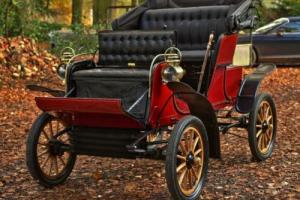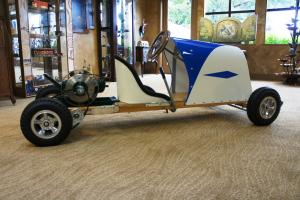Classic Cars / TEST / Car for sale
1938 Maytag Boy Race Car Like in the Little Racals Movie Sprint Car Indy
Sale price: $4,859.00 Make an offer
Car location: Gig Harbor, Washington, United States
Sale type: Fixed price listing
Technical specifications, photos and description:
- Make:
- other makes
- Model:
- Maytag Replica Race Car
- Year:
- 1938
- Type:
- convertible
- Engine:
- maytag
- Fuel Type:
- Gasoline
- Trim:
- none
- Vehicle Title:
- Clear
- Got questions?
- Ask here!
1938 Maytag Boy Race Car Like in the Little Racals Movie Sprint Car Indy for sale
Current customer rating:
We sold the Red one and this is the last known little Maytag we know of for sale anywhere. You have heard that good things come in small packages and that is true of the Maytag powered children's race cars. Here is a bit of history about the small but very significant racers that were popular in the 1920 s and 1930 s. The Maytag Racers contributed to the launching of two major children's racing associations that exist to our day and were the predecessor of the modern racing go-kart with its sidewinder mid-mounted engine.
In 1915 Maytag introduced the Multi-Motor gasoline powered clothes washing machine which enabled homes without electricity to have the convenience of a washer. “Starting the wash” meant Mom had to mix the oil and fuel mixture. put the 30 foot exhaust hose with muffler outside the back door. add the detergent and kick start the motor to life. The 1920's brought electricity to many more homes and the retired Multi-Motors began to stack up at Maytag dealers as the older washers were converted to electric power. Eventually some of these motors found their way into kid's homebuilt race cars and even Maytag took note of the trend and in 1934 introduced a Maytag factory produced Racer.
Production continued until 1941 (WWII). There were 498 production toy racers built with only about 35 surviving cars today. An original Maytag Toy Racer now commands $20. 00+ and is a prized Maytag collectible. The Maytag Toy Racer production numbers were probably just a fraction of the total number of Maytag powered racers which were built by parents and kids using the obsolete and discarded engines. Both the production and homebuilt cars hold an important place in auto racing history as these cars were the predecessors of Quarter Midget Racers that launched the careers of many famous drivers. The original Soap Box Derby racers date from this time period and probably both provided and received some inspiration from their Maytag powered counterparts. Both of these fine racing associations continue to this day introducing thousands of kids to basic driving skills. racing competition and good sportsmanship.
Maytag dealers were always anxious for more publicity for their stores and often provided decals and other sponsorship benefits for racers in addition to promoting parades and races. Their sponsored race drivers and cars were often featured in the newspaper ads for their Maytag dealerships. Some creative dealers “employed” their young sponsored drivers to sign up their parents and neighbors for home demonstrations of Maytag products.
Maytag racers became stars of the silver screen. In 1931 a Fox Movietone News short showed 50 Maytag powered racers racing in Salt Lake City. Little Rascals fans will recall episode #183 “Auto Antics” with Butch and Al falfa racing soap box derby style
cars.
Butch's had a hidden Maytag motor. Alfalfa
(Carl Switzer)
was quite the practical joker and liked to goof off in scenes intentionally and one of the racing scenes required over 30 retakes. Eventually the two stroke engine exhaust fumes overcame Darla who passed out and was rushed to the hospital. The director abandoned any more retakes and edited out Alfalfa's on-camera antics.
Even the hallowed racing ground of the Indianapolis Motor Speedway felt the impact of these little Maytag racers as the "Indianapolis Children's Speed Classic" was staged there on May 26-27. 1934. Oil drums were placed on the main straightaway to mark out a small oval where the racers reached up to 20 MPH. Floyd "Pop" Dreyer of the Duisenberg Brothers Indianapolis race car shop built a car that was driven by his three-year old son.
The Maytag engine used on most racers was the two-cycle ¾ horsepower model #92 single cylinder engine which netted a then thrilling 8 MPH with modified cars hitting 20 MPH. The rear wheel brakes and clutch are controlled by the lever on the right hand side of the car. The speed of the car is controlled by how much tension is placed on the drive belt. Remember that many midget race cars from this era also used a similar lever operated hand brake. The engine has no throttle and uses a “hit and miss” type of magneto ignition arrangement to keep engine speed at a steady 1100 RPM. This causes a unique popping engine sound as the magneto cuts out the ignition to slow the RPM. A few states including California and Tennessee allowed the cars to be registered for road use.
The car is a 1938 Maytag Sidewalk Runabout Racer Re-creation with an authentic Maytag model #92 single cylinder motor from a 1930's vintage Maytag washer. They are completely functional and ready for racing with other similar cars. They are constructed as per the original drawings in a May 1938 Modern Mechanix Magazine article. The value of original cars has gone so high that they are seldom driven and have become museum or collector owned display pieces. Only one is known to be in running order. Many of the original cars probably ended up as carnival rides and eventually were discarded as the years and usage took their toll. Sadly very few automotive enthusiasts are aware of the important role these cars played in automotive racing history.
There is not title needed for a replica (miniature) racer and this little car is not street legal.
Go for it. What fun for you collection.
In 1915 Maytag introduced the Multi-Motor gasoline powered clothes washing machine which enabled homes without electricity to have the convenience of a washer. “Starting the wash” meant Mom had to mix the oil and fuel mixture. put the 30 foot exhaust hose with muffler outside the back door. add the detergent and kick start the motor to life. The 1920's brought electricity to many more homes and the retired Multi-Motors began to stack up at Maytag dealers as the older washers were converted to electric power. Eventually some of these motors found their way into kid's homebuilt race cars and even Maytag took note of the trend and in 1934 introduced a Maytag factory produced Racer.
Production continued until 1941 (WWII). There were 498 production toy racers built with only about 35 surviving cars today. An original Maytag Toy Racer now commands $20. 00+ and is a prized Maytag collectible. The Maytag Toy Racer production numbers were probably just a fraction of the total number of Maytag powered racers which were built by parents and kids using the obsolete and discarded engines. Both the production and homebuilt cars hold an important place in auto racing history as these cars were the predecessors of Quarter Midget Racers that launched the careers of many famous drivers. The original Soap Box Derby racers date from this time period and probably both provided and received some inspiration from their Maytag powered counterparts. Both of these fine racing associations continue to this day introducing thousands of kids to basic driving skills. racing competition and good sportsmanship.
Maytag dealers were always anxious for more publicity for their stores and often provided decals and other sponsorship benefits for racers in addition to promoting parades and races. Their sponsored race drivers and cars were often featured in the newspaper ads for their Maytag dealerships. Some creative dealers “employed” their young sponsored drivers to sign up their parents and neighbors for home demonstrations of Maytag products.
Maytag racers became stars of the silver screen. In 1931 a Fox Movietone News short showed 50 Maytag powered racers racing in Salt Lake City. Little Rascals fans will recall episode #183 “Auto Antics” with Butch and Al falfa racing soap box derby style
cars.
Butch's had a hidden Maytag motor. Alfalfa
(Carl Switzer)
was quite the practical joker and liked to goof off in scenes intentionally and one of the racing scenes required over 30 retakes. Eventually the two stroke engine exhaust fumes overcame Darla who passed out and was rushed to the hospital. The director abandoned any more retakes and edited out Alfalfa's on-camera antics.
Even the hallowed racing ground of the Indianapolis Motor Speedway felt the impact of these little Maytag racers as the "Indianapolis Children's Speed Classic" was staged there on May 26-27. 1934. Oil drums were placed on the main straightaway to mark out a small oval where the racers reached up to 20 MPH. Floyd "Pop" Dreyer of the Duisenberg Brothers Indianapolis race car shop built a car that was driven by his three-year old son.
The Maytag engine used on most racers was the two-cycle ¾ horsepower model #92 single cylinder engine which netted a then thrilling 8 MPH with modified cars hitting 20 MPH. The rear wheel brakes and clutch are controlled by the lever on the right hand side of the car. The speed of the car is controlled by how much tension is placed on the drive belt. Remember that many midget race cars from this era also used a similar lever operated hand brake. The engine has no throttle and uses a “hit and miss” type of magneto ignition arrangement to keep engine speed at a steady 1100 RPM. This causes a unique popping engine sound as the magneto cuts out the ignition to slow the RPM. A few states including California and Tennessee allowed the cars to be registered for road use.
The car is a 1938 Maytag Sidewalk Runabout Racer Re-creation with an authentic Maytag model #92 single cylinder motor from a 1930's vintage Maytag washer. They are completely functional and ready for racing with other similar cars. They are constructed as per the original drawings in a May 1938 Modern Mechanix Magazine article. The value of original cars has gone so high that they are seldom driven and have become museum or collector owned display pieces. Only one is known to be in running order. Many of the original cars probably ended up as carnival rides and eventually were discarded as the years and usage took their toll. Sadly very few automotive enthusiasts are aware of the important role these cars played in automotive racing history.
There is not title needed for a replica (miniature) racer and this little car is not street legal.
Go for it. What fun for you collection.
Want to buy this car?
Comments and questions to the seller:
from Richard Russ, dated 28 april 2020What is the price of the Maytag racer you are building
from john kinsella , dated 19 june 2017
is the Magtag racer still for sale
Other classic TEST cars offered via internet auctions:
 price: $US $18,995.001982 Other Makes
price: $US $18,995.001982 Other Makes price: $35,000.001958 BUCHANAN FIBRE GLASS SPORTS CAR ON 1500 MG
price: $35,000.001958 BUCHANAN FIBRE GLASS SPORTS CAR ON 1500 MG price: $15,500.001985 Trihawk Excellent Condition!
price: $15,500.001985 Trihawk Excellent Condition! price: £125,000.001903 STEVENS-DURYEA 7hp MODEL L RUNABOUT
price: £125,000.001903 STEVENS-DURYEA 7hp MODEL L RUNABOUT
Latest arrivals:
-
£8,250.000
-
£6,995.000
-
£8,250.000
-
£3,600.000
-
£10,000.000
-
£29,500.000
-
£39,500.000
-
£15,500.000
-
£12,000.000
-
£3,695.000
-
£2,650.000
-
£3,899.000
-
£30,000.000
-
£22,366.000
-
£5,000.000
-
$14,000.000
-
£23,500.000
-
£7,000.000
-
£21,000.000
-
£18,500.000































